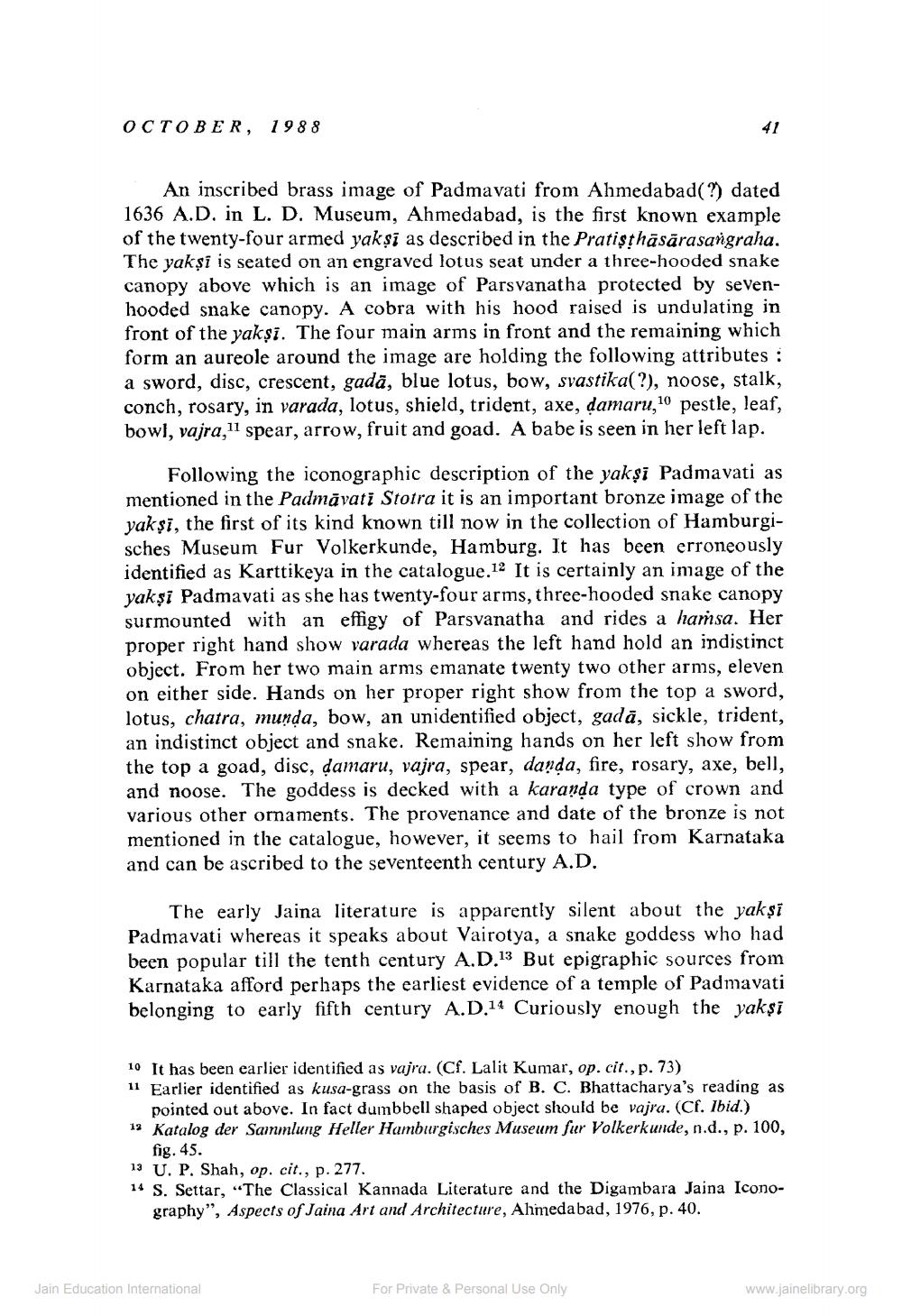________________
OCTOBER, 1988
An inscribed brass image of Padmavati from Ahmedabad(?) dated 1636 A.D. in L. D. Museum, Ahmedabad, is the first known example of the twenty-four armed yakṣi as described in the Pratiṣṭhāsārasangraha. The yakși is seated on an engraved lotus seat under a three-hooded snake canopy above which is an image of Parsvanatha protected by sevenhooded snake canopy. A cobra with his hood raised is undulating in front of the yakṣi. The four main arms in front and the remaining which form an aureole around the image are holding the following attributes: a sword, disc, crescent, gadā, blue lotus, bow, svastika(?), noose, stalk, conch, rosary, in varada, lotus, shield, trident, axe, damaru, 10 pestle, leaf, bowl, vajra,11 spear, arrow, fruit and goad. A babe is seen in her left lap.
41
Following the iconographic description of the yakşi Padmavati as mentioned in the Padmavati Stotra it is an important bronze image of the yakşi, the first of its kind known till now in the collection of Hamburgisches Museum Fur Volkerkunde, Hamburg. It has been erroneously identified as Karttikeya in the catalogue.12 It is certainly an image of the yakşi Padmavati as she has twenty-four arms, three-hooded snake canopy surmounted with an effigy of Parsvanatha and rides a hamsa. Her proper right hand show varada whereas the left hand hold an indistinct object. From her two main arms emanate twenty two other arms, eleven on either side. Hands on her proper right show from the top a sword, lotus, chatra, munda, bow, an unidentified object, gadā, sickle, trident, an indistinct object and snake. Remaining hands on her left show from the top a goad, disc, ḍamaru, vajra, spear, danda, fire, rosary, axe, bell, and noose. The goddess is decked with a karanda type of crown and various other ornaments. The provenance and date of the bronze is not mentioned in the catalogue, however, it seems to hail from Karnataka and can be ascribed to the seventeenth century A.D.
The early Jaina literature is apparently silent about the yakṣi Padmavati whereas it speaks about Vairotya, a snake goddess who had been popular till the tenth century A.D.13 But epigraphic sources from Karnataka afford perhaps the earliest evidence of a temple of Padmavati belonging to early fifth century A.D.14 Curiously enough the yakşi
10 It has been earlier identified as vajra. (Cf. Lalit Kumar, op. cit., p. 73)
11 Earlier identified as kusa-grass on the basis of B. C. Bhattacharya's reading as pointed out above. In fact dumbbell shaped object should be vajra. (Cf. Ibid.)
12 Katalog der Sammlung Heller Hamburgisches Museum fur Volkerkunde, n.d., p. 100, fig. 45.
13 U. P. Shah, op. cit., p. 277.
14 S. Settar, "The Classical Kannada Literature and the Digambara Jaina Iconography", Aspects of Jaina Art and Architecture, Ahmedabad, 1976, p. 40.
Jain Education International
For Private & Personal Use Only
www.jainelibrary.org




